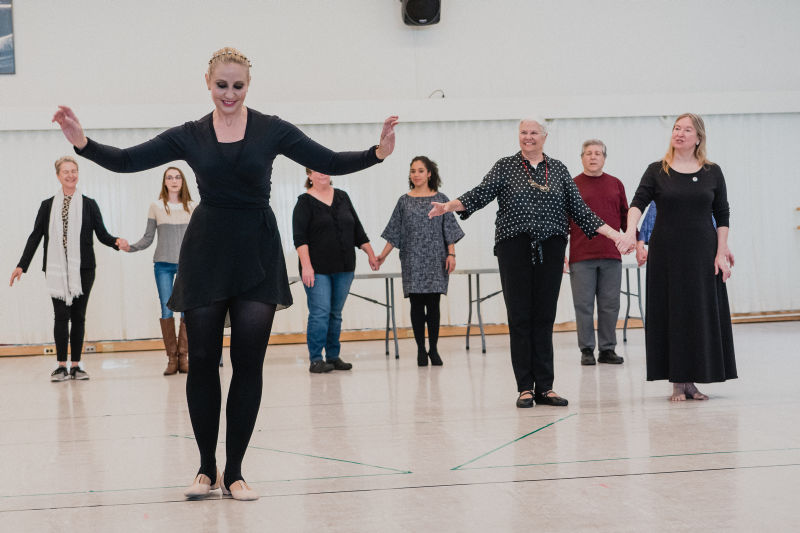For dancers, strengthening acting ability can enhance not only artistry and confidence but also storytelling onstage. After all, there is a lot of overlap between the two art forms. “Acting is mostly listening and being present,” says Isadora Wolfe, the associate artistic director of Sleep No More and a teacher of the Acting for Dancers class at The Juilliard School. “Dancers have those skills. That’s what we’re doing all the time: listening in a million different ways.”
Find Your Voice
Venturing into a new art form requires stepping beyond comfort zones and facing uncertainty. This discomfort can be a catalyst for growth, however, fostering adaptability and expanding creative horizons. Many dancers aren’t accustomed to using their voices onstage, so vocalizing for the first time onstage can be intimidating. Wolfe says a willingness to try is important: “When we’re embarrassed about our voice, or feel shame about it, or just feel funny about it because we haven’t used it a lot, we cut off a certain amount of impact and energy, even if we’re doing a project that’s completely silent.”
Wolfe recommends dancers practice a series of simple vocal warm-ups (see sidebar) to get more comfortable using their voice. It can also be helpful to practice delivering a monologue. “Start to listen to yourself saying the words,” Wolfe says. “You can video yourself. If you have someone else, whether that’s a friend or a roommate or a family member, becoming comfortable speaking words out loud in front of them is another way to start to become comfortable with your voice, be able to hear yourself, and loosen your inhibitions.”
Draw on Emotion
Learning to act involves exploring a range of emotions and an understanding of how to authentically portray them. Dancers who study acting can tap into a wider range of emotions, enabling them to convey more nuanced and compelling stories through their movements. Bharathi Penneswaran, a New York City–based bharatanatyam teacher, performer, and artistic director of Aalokam, says that paying attention to the way feelings affect the body in day-to-day life can help in expressing the same feelings onstage. “What happens when your body is happy? Do you move your limbs? Do you look very stiff? Or is it just your face that shows the expression?” she asks.
Kristi DeCaminada, a principal character dancer at San Francisco Ballet, adds that it’s important to pay attention to facial expressions when focusing on emotion in dance performance. She recommends using the mirror to gauge whether facial expressions are matching the energy of the dancing, the music, and the story. “The expression on your face can’t be overexaggerated; it has to be natural and believable,” she explains. “It has to be something you would do—it has to be your own and how you would interpret that emotion.”
Stretch Your Artistry
Dancers interested in improving their acting can adopt various strategies as a starting point. Enrolling in acting classes, or workshops specifically designed for dancers, can provide a structured foundation. These classes often focus on fundamental principles, such as character development, emotional expression, and improvisation. Wolfe encourages dancers to take part in community theater productions as a way to gain invaluable experience. “If you can get involved with a non-Equity production or a community production, you will learn a ton about how a piece of theater is made,” she explains. “There will most likely be people in the room that have a ton of training, so just being in the rehearsal room in a production of any level will be an acting class in and of itself.”
DeCaminada highlights the value of observing other dancers in rehearsal and onstage, as well as on video. Pay attention to how they interpret a role, infuse each step with emotion, and use the choreography to tell a story. “Watching as much dance as possible, and watching as many movies and as much acting as possible, is so important,” she says.

Warm Up Your Voice
Isadora Wolfe, an Acting for Dancers teacher at Juilliard, recommends these vocal warm-ups for dancers learning to find their voices:
- Face and jaw massage: Gently massage the chin, jaw, sinuses, and temples with your fingertips. “Part of preparing your voice is relaxing as much as possible, to produce the healthiest and richest sound,” Wolfe says.
- Lip buzz/trill: Press your lips together and blow out slightly, making a buzzing sound. See if you can maintain this sound while changing octaves.
- Humming: Wolfe says humming, whether it’s a scale or your favorite song, is a great warm-up or cool-down exercise that won’t strain your vocal cords.
